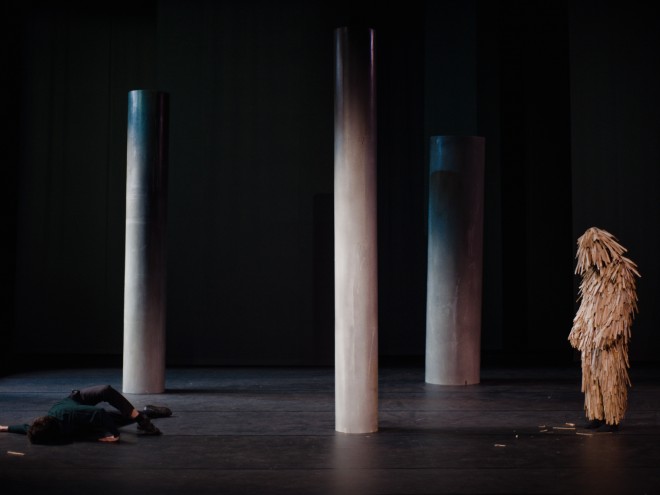
Bart Meuleman: Are you making costumes or objects for Matisklo?
Max Pairon: Something in-between the two, or perhaps neither. But for me it’s more about the materials and the use they are put to. I might start out making a costume, but then if I don’t find the way I am using the chosen material interesting, it becomes an object.
Bart: What did you base the costumes/objects on? On Celan’s poems? Or did you draw on the world of your imagination?
Max: More the second, I think. I found a connection with Celan’s work in the materiality which fascinates me and which is regularly a feature of Celan’s work too. For me there is often something of a nature study about his representation of the world. But initially I didn’t have an affinity with his work; it was Bosse who introduced me to it. As we put flesh on the bones of the production, I gradually started to get into his work. That approach plus my own imagination led to what we have now.
Bart: What was your reason for getting involved in this process in the first place?
Max: Bosse invited me. He had come to look at my graduation project, De vergissing. I had already made a number of costumes.
Bart: Are you reusing them in Matisklo?
Max: Some of them, yes. After studying drama (KASK), I felt the need to use my hands again (laughs).
Bart: So for this work you drew largely on your own imaginary world? Where did ideas like the ‘brush man’ come from?
Max: I use my eyes, I look at materials and ask myself: what can I do with that? How far can I go with that? What really interested me about working on that ‘saté skewer costume’ (i.e. the ‘brush man’) was the sound it would make. How it would rustle. The imagery it evokes is what it’s all about for me. In the end we used reeds for the costume, because otherwise it would have
been too heavy.
Bart: Were you looking to contrast your costumes which speak very directly with Celan’s cryptic poetry?
Max: What I find so interesting about making costumes from those sort of materials are their limitations. You have to work with them. That is very different from a costume. Those limitations have great poetic qualities for me. And yes, I did find that the notion of ‘limitation’ linked up with Celan’s imagery.
Bart: So you brought to this process your own world, with the focus on unusual materials and what you could do with them?
Max: That’s what I tried to do, yes.
Bart: How did you collaborate with Bosse? Did you come up with suggestions?
Max: I was given the freedom to introduce materials. Bosse trusted my judgement on that. What eventually happened with the objects was more his responsibility. But we did consult and reach agreement about those things. Above all, I had the opportunity to try out ideas I already had and run with them. I was able to concentrate on that aspect. And as a costume designer, I was really excited by the idea of working with a director.
Bart: So can I conclude that you want to continue working with those sort of materials and costumes in a performance of your own?
Max: Yes, it’s something I’m working on. I would like to make a landscape with those sort of objects, a huge space that engulfs you.
Bart: Did the Matisklo process sharpen that ambition?
Max: Absolutely. And now I am also less afraid to think in terms of simplicity and abstraction.
Bart: What would a landscape be like in which there is movement, a choreography for your objects in which there are always people?
Max: Not necessarily with people in them, though probably a human dimension. But underlying it all is still the materiality. A space full of sticks for example, that’s what I’m thinking of.
← Back to overview